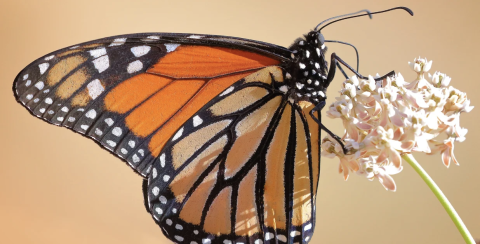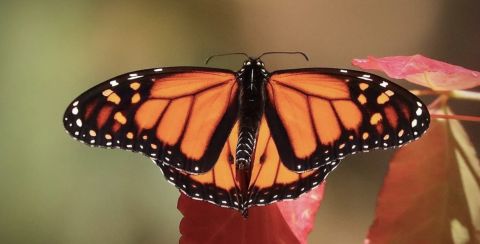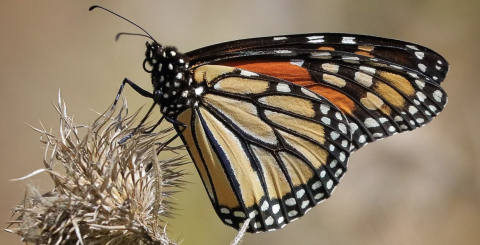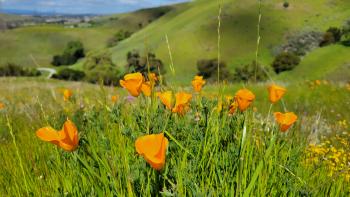Protecting Monarch Butterflies
With its quintessential bold orange wings and black markings, the monarch butterfly is a global celebrity with populations existing in places like New Zealand, South America, Puerto Rico and India. The western monarch, in particular, has a large presence in Mexico which has made it a particularly significant cultural symbol, especially during Día de los Muertos. Despite recent population declines of this popular species, new research is giving hope that this meaningful cultural figure will fight the risk of extinction.

In North America, hundreds of thousands of monarch butterflies migrate south from places as far north as Canada seeking a warmer climate during the winter. Monarchs west of the Rocky Mountains travel down to the California coast to establish a home for the winter while monarchs east of the Rocky Mountains migrate to Mexico and find seasonal homes in protected areas within their preferred habitat, pine and fir forests.
Right on schedule, the western monarch butterfly arrives to Mexico in tandem with the kick-off of Día de los Muertos celebrations. During Día de los Muertos, which takes place each year on November 1 and 2, Mexican families welcome the spirits of deceased loved ones into their homes to eat, dance and be together in a joyous atmosphere. In Mexican folklore, and especially among Indigenous populations like the Purépecha and the Mazahua, western monarch butterflies are thought to carry the souls of deceased ancestors who have returned home to visit their families and, over time, have become a symbol of these celebrations.

Researchers are seeing a decrease in the number of western monarch butterflies completing their typical migration paths as well as a decline in the species’ overall population. Rising temperatures due to climate change make milkweed, a plant that monarch butterflies depend upon for survival, less available. This plant not only acts as a shelter for the butterflies, but it’s also a food source and a place for monarchs to lay eggs throughout their life cycles.
When milkweed is not readily accessible, it increases the chance that monarchs will endure a difficult migration path which results in fewer monarch butterflies reaching their destination. In addition, extreme heat is decreasing the butterfly’s likelihood of survival, repopulation and becoming pollinators for plants, wildflowers and agriculture along their migration path.
Butterflies, along with bees, birds and other insects are shown to be responsible for one out of every three bites of food we eat. When the monarch population is at risk, there’s a chance that there will be fewer pollinators in our environment which can potentially lead to a decrease in the production of agriculture.

The good news is, there is hope for monarch butterflies as improvements have been made to the way this iconic species is monitored through important community science initiatives. In 2018, it was reported that there were 30,000 western monarch butterflies in California and only five years later, 233,394 western monarch sightings were documented throughout the state. This increase in the population size is due to researchers calling upon community members to assist in reporting western monarch butterfly sightings. As a result, scientists accounted for more butterflies in locations along their migratory paths, rather than just monitoring the sites where they are known to rest during the winter. As the butterflies continue to fight the effects of climate change, there are steps everyone can take to support monarchs and many other important pollinator species.
Planting milkweed is one way to help, which provides monarchs with a familiar place to rest, lay eggs and shelter. The Open Space Authority actively plants milkweed in open spaces to offer monarch butterflies a safe, native habitat along their migration route. Also, cultivating plants that flower year-round, such as nectar plants, helps many different pollinators, including butterflies, refuel along their migratory paths.

Open Space Authority staff and volunteers continue to plant native milkweed and nectar plants to help pollinators - including western monarch butterflies - which are just one of the many important native wildlife species that can be seen in your open spaces.
Although monarchs continue to face challenges, there is hope that this population will rebound and continue to grow. This is incredibly important as it means that monarch butterflies will continue to be deeply rooted within the Mexican culture and, specifically, Día de los Muertos celebrations.
Learn more about endangered monarch butterflies by reading past blog posts from the Open Space Authority on this topic here and here. A Spanish version of this blog post can be found here.
Help Protect Western Monarch Butterflies
- Support the protection of local overwintering sites - essential habitat for western monarchs during the cold months.
- Plant native flowers that attract western monarch butterflies and other pollinators. Use this monarch nectar plant guide to choose the best native plants for your area.
- Also, if you live in the Santa Clara Valley, planting a native milkweed variety can provide western monarchs with food and a place to lay their eggs.
- Stop the use of pesticides at your home and in your garden which can negatively impact the western monarch's ability to survive.
- Help count western monarchs!
